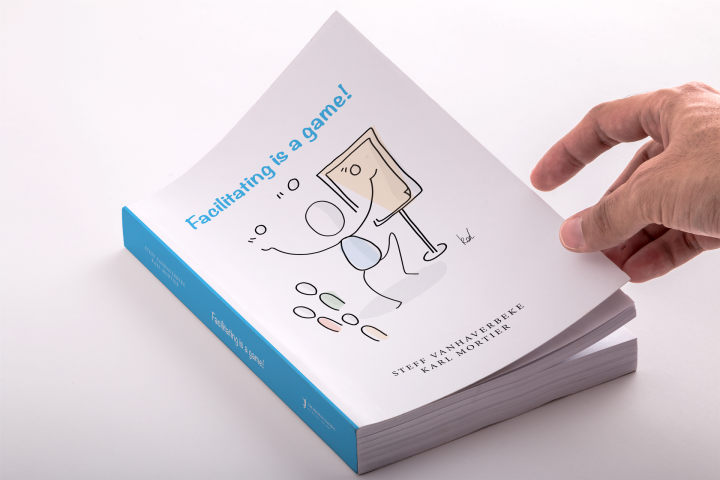

The difference between coaching and facilitation.
You are in another meeting - or no wait - yet another team meeting... You have prepared the agenda tightly and you are ready to lead the troops through the jumble of action points. While you hope for a consultation in which everyone participates constructively, however, you notice that the zest is out... A few colleagues dominate - the usual suspects. The rest look absent-minded or try to secretly answer their emails... For twenty minutes, you listen to the same mediocre ideas from the same two people who always sit around arguing.
You know this is the moment to intervene. But how?
You don't want the energy to go down even more. Nor do you want to point fingers. What you do want is to get the group going. That ANYONE actively participates. What are you going to do? Coach people? Or facilitate the group?
Good news, there are tools for this. So if you recognise the above scenario, be sure to read on!
Because here is your survival guide for determining when to put on which hat. Because yes, even that one participant who thinks he knows everything better has potential... but you need to know how to bring it out.
Steer or let go?
You can almost predict what's coming... Mark starts up again about the same project he's brought up a hundred times, and Marieke is deeply absorbed in her phone. What do you do now?
It sometimes feels like you are leading a kindergarten class, but you are not a teacher, are you? No, you're a leader. You want everyone to participate and come up with new ideas. But yes, if you let go too much, the whole thing goes haywire. And if you direct too much, you're just regurgitating everything.
Then again, you are doing all the thinking for the whole group.
The fear of making the wrong choice
The problem is that you are afraid of losing control. Because what if you intervene too early? Or what if you let them swim and they drown? You can imagine it: everyone is looking to you for a solution, while you quietly want people to put their brains to work themselves.
Spoiler alert: that won't happen by itself!
When do you use which approach?
OK, here's the simple answer: you don't have to choose! You can be both, as long as you know when to switch. Let's go through a few situations so you don't get stuck.
Coaching: getting the best out of people without saying a word (okay, almost)
As a coach, you are there to help people reach solutions on their own. You know they already have the answers somewhere inside them, but sometimes they need a push. Or a firm push, let's face it. 😅
Example. You're in a brainstorm, and after three suggestions, the creative well runs dry. What do you do? Instead of bringing in a brilliant idea of your own (I know you have one, but just don't do it right now ), you ask questions like: ‘What would you approach differently if there were no constraints?’ or ’What are you overlooking that could really help us move forward?’ Yes, coaching is about asking questions that trigger the thinking process of others. Spoiler alert 2.0: people often love coming up with the solution themselves (and they secretly like it when you respect that).
Facilitate: be the director of the process, not the star of the show
Facilitation is your thing when the group could use some guidance to keep the conversation from degenerating into a wild west show. Your job is to keep time, maintain structure and make sure everyone has a chance to contribute. You're not the main act, but without you, the circus is in shambles.
Example. Same meeting, same few people talking. But now you can activate the whole group: ‘First, let's collect some ideas. Take a sheet of paper each and write down 3 things that you yourself think are important. And then ‘s 3 that you already know are too difficult.’ Then have people compare their ideas in pairs and open a discussion.
That way, you give people space without dominating the conversation. You are the conductor of the orchestra, not the violinist who has to come to the fore.
Reframing, the secret sauce for both coaching and facilitating
And here comes the trick: reframing. In other words, looking at the problem from a different angle. Whether you are coaching or facilitating, this is your secret weapon for getting people to look at the situation differently.
Example as a coach:
‘What if this problem is actually an opportunity? How would you approach it then?"
Example as facilitator:
‘Interesting discussion, what stands out? And what if we look at it from the customer's position? What do we notice then?"
These kinds of questions sharpen your thinking without having to come up with a ready-made solution yourself. When do you choose which role? Now comes the best part: you don't have to adopt the same role all the time. The key lies in sensing what the group needs at that moment. Here is a simple guideline:
- Coach: if you know the group is capable of coming up with ideas but is stuck in familiar patterns.
- Facilitator: if you notice that the group needs structure and that the conversation is going in all directions (except the right one).
It's not an exact science, but with some practice you will learn to switch effortlessly between the two roles. The result? Better sessions, more engagement and-oh yes-a lot less stress for you.
So time to put some of this into practice
Would you like to experience for yourself when to coach and when to facilitate? Then register for our Facilitating Masterclass and learn how to switch effortlessly between these roles. Because let's face it: sometimes you just need a little practice to know what works.


